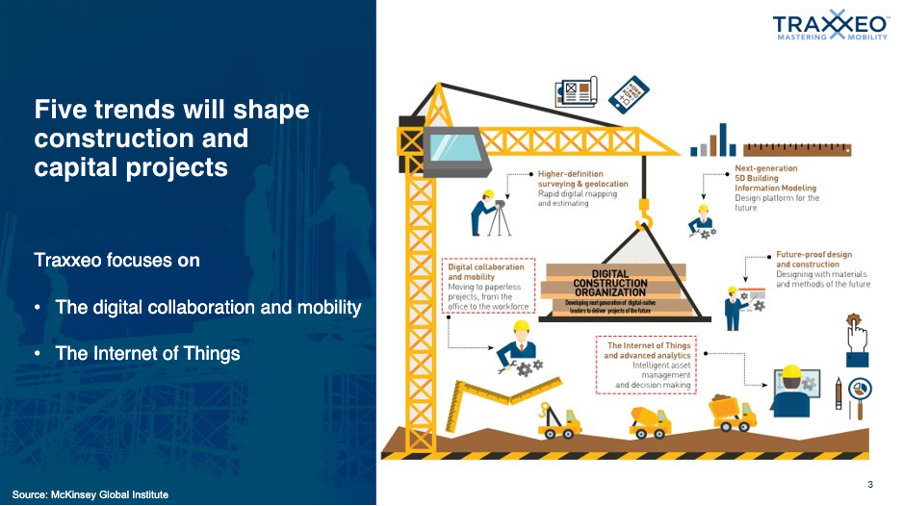
Digital technology is changing the way that the construction industry operates across the world. Traditional and well-established ways of working are increasingly being superseded by using technology to make these processes safer, faster, more efficient and more cost effective. Here, we discuss the many advantages of adopting this digital technology, along with some of the reasons that are commonly given as being barriers to it and the resulting consequences of non-digitalisation.
The state-of-the-art in construction digital technology is constantly evolving. At the moment, it includes things such as: (1) high-definition surveying and geolocation, (2) next-generation 5D building information modelling (BIM), (3) digital collaboration and mobility, (4) the Internet of Things (IoT) and advanced analytics, and (5) future-proofing of design and construction. At Traxxeo, our focus is primarily on using IoT, web and mobile technologies to enhance digital collaboration and mobility, particularly in terms of intelligent asset management and decision making.

Advantages of digitalisation for construction companies
It is generally quite obvious how digital technology has improved our everyday lives, from the convenience of online banking and shopping to virtual meetings with people around the world. But the advantages for construction companies of adopting digital tech are sometimes a little less evident. The list below isn’t exhaustive, but some of the benefits of digitalisation often include:
- Improved operational efficiency – This is one of the key advantages of adopting digital tech. By working smarter and more dynamically, it is usually very easy to reduce production costs and boost productivity. This has been a driver for developments in industry for many years and digitalisation is now the tool that is best placed to achieve this. Improving operational efficiency will have a major positive impact on a company’s results.
- Improved health, safety and wellbeing – Companies have a legal responsibility to ensure the health and safety of their employees. Digital tech can significantly improve safety standards in the workplace; for example, by making sure that a person has the correct certification before accessing a hazardous area. Also, providing an environment where staff are happy and not constantly frustrated by inefficient ways of working can have a beneficial impact on wellbeing in the workplace.
- Better quality products and services – Smarter ways of working will lead not only to cost savings but also to a better finished product. This is great for your reputation and strengthens the customer relationship.
- Improved internal and external communication – Communication is always key in any business and so there is a competitive advantage if it is dynamic and efficient. The days of filling out sheets of paper and sending these to the head office are well and truly numbered.
- Employee retention – No one likes working in a dated and stagnant environment. Working in ways that use inefficient practices is bad for the company’s bottom line and it’s also bad for staff morale. If people are happy in their jobs, they are less likely to move elsewhere.
- Attracting new talent – It has been shown that many people, particularly younger generations, are keen to embrace modern technology in their working lives. A company that is keeping up to date with tech is likely to be a more appealing proposition for potential employees, which is vital for long-term growth.
Barriers to digitalisation
Every company is unique and will face its own challenges and barriers to bringing in digital technology, but there are several common themes that arise. One of the barriers that is cited most often is the investment cost. While there will inevitably be expenditure that is required, this can be put into perspective by calculating the return on investment and also by phasing in the digitalisation process to help spread the cost.
There are also sometimes organisational barriers. These can include the internalisation of IT developments, the absence of management sponsorship, and the fact that it is generally not a strategic subject and therefore not always a priority. At the HR department level, there is sometimes a lack of internal resources and a resistance to changing established practices. However, these factors can usually be overcome with a change in mindset and appropriate management instruction.
Finally, a lack of time is frequently mentioned as a barrier to digitalisation. As with the cost aspect, going digital will inevitably involve a time outlay but this is often less than expected and the payback in terms of increased efficiency soon offsets this.
Change is not always easy but it is necessary to remain competitive.
Consequences of non-digitalisation
So, what are the impacts of letting these barriers stop you adopting digital tech in construction?
The inefficient and error-prone collection of information from the worksite, and the poor management of material and human resources, will inevitably lead to imperfect decision making and higher costs. Delays and unplanned costs of operations will impact the budget and schedule of a project and could also be detrimental to quality. The failure to increase productivity and operational efficiencies will mean that your company stands still, rather than develops and moves forward.
Not being up to date with new information technology means that existing inefficient methods of communication will continue to be used, both internally and externally (for example, how are the companies that are still using fax machines viewed? – probably not very positively). There are also ‘invisible’ costs associated with traditional communication, such as paper, printer ink, photocopier maintenance, etc, not to mention time costs, that are sometimes overlooked.
The outcome of these negative consequences will be a degradation of the customer relationship and an increasing lack of competitiveness in the marketplace. There could also be a talent drain of employees away from the company.
How to bring in digital solutions
Listed below are a few key points that will enable and enhance the digital transformation in a construction company.
- Make digitalisation a strategic and priority topic – This will ensure that it receives the attention it requires at all levels of the organisation.
- Management must take charge of and subsidise the digitalisation project – Management support is required to drive the project forwards and ensure that it is fully embraced by the whole company. Adequate funds also need to be provided by management so that the most appropriate – not just the cheapest – digital solution is implemented.
- Appoint a digital transformation manager and set up a dedicated committee with a well-defined roadmap (recruit these people if necessary).
- Find a trusted partner, such as Traxxeo, that can provide valuable expert advice.
- Secure the right financing, e.g. state aid, suppliers with scalable offers, etc.
- Develop the professions where tasks are likely to be automated with digital technology – This might involve training existing employees to teach them additional skills or recruiting new people with talents that are currently not present within the company.
If these points are followed, then it will give you a great platform to adopt digital tech with as little interruption as possible to normal business and to see the benefits that it brings within the shortest timeframe. Digitalisation offers the opportunity to gain numerous benefits that will be vital for the long-term success of a company and, as such, it should be welcomed.